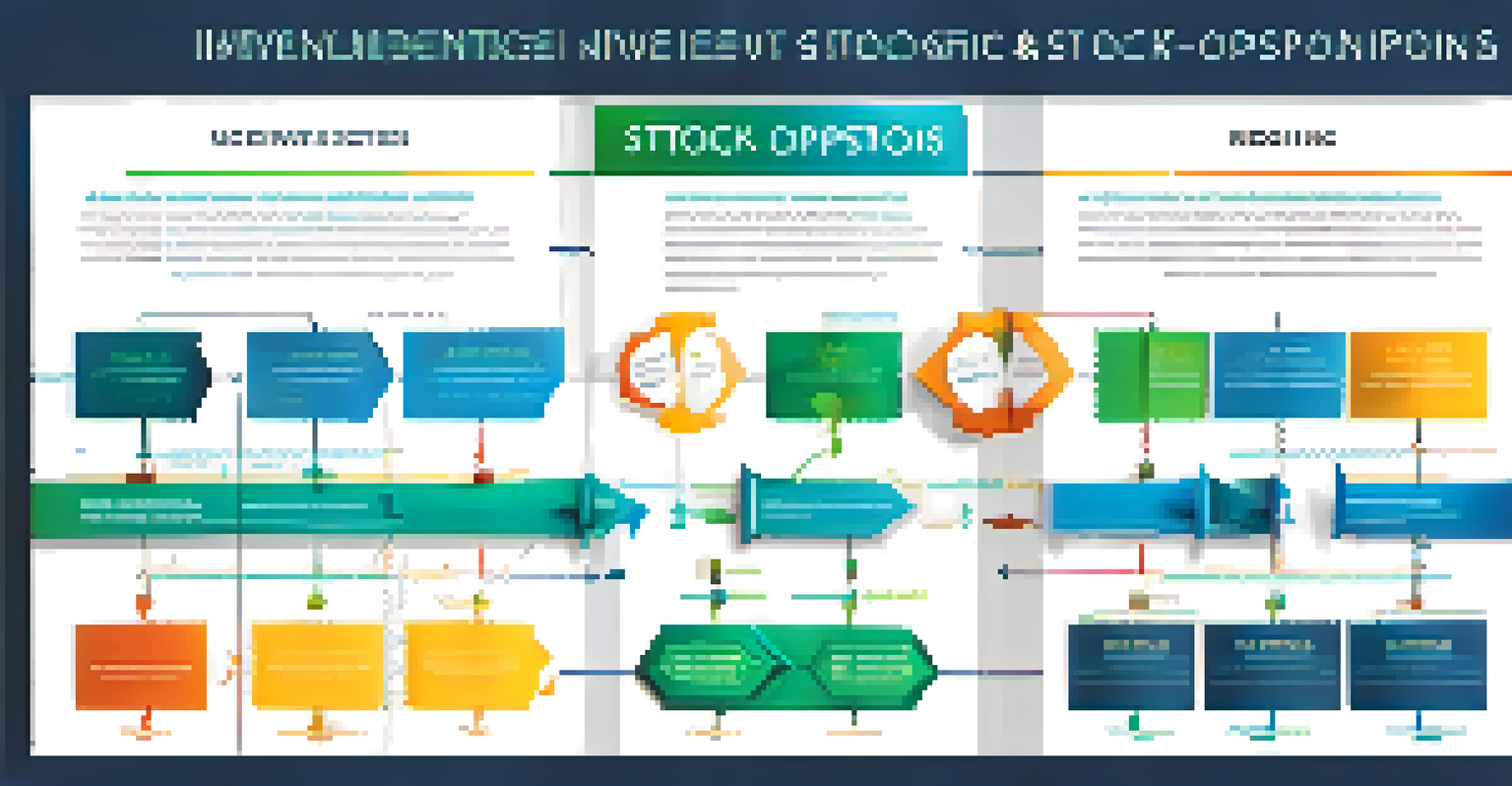Impact of Different Types of Employee Stock Options on Taxes

What Are Employee Stock Options?
Employee stock options (ESOs) are contracts that give employees the right to purchase shares of their company's stock at a predetermined price, known as the exercise price. They often serve as an incentive for employees to contribute to the company’s success, aligning their interests with those of shareholders. Think of ESOs as a way for companies to reward their employees with a piece of the pie, allowing them to benefit from the company’s growth.
The stock market is filled with individuals who know the price of everything, but the value of nothing.
There are two main types of employee stock options: Incentive Stock Options (ISOs) and Non-Qualified Stock Options (NSOs). ISOs generally offer favorable tax treatment but come with specific conditions, while NSOs are more flexible but may result in higher taxes upon exercising. Understanding these types is crucial, as they can significantly impact your financial decisions and tax liabilities.
When it comes to exercising stock options, it’s essential to consider both the timing and the tax implications. The moment you exercise your options, it triggers different tax treatments depending on whether your options are ISOs or NSOs. This decision can ultimately affect your overall financial picture, so it’s important to approach it thoughtfully.
How Incentive Stock Options (ISOs) Work
Incentive Stock Options, or ISOs, are a popular choice among companies looking to attract and retain talent. They allow employees to buy stock at a fixed price, typically lower than the market value, without immediate tax consequences upon exercise. However, ISOs come with specific requirements, such as holding periods, which can complicate matters if not properly understood.

One of the primary benefits of ISOs is the potential for favorable tax treatment. If you meet the holding period requirements, the profit from selling the stock may be taxed at the long-term capital gains rate, which is often lower than ordinary income tax rates. This can lead to substantial tax savings, especially if the stock appreciates significantly.
Understanding ESOs Basics
Employee stock options (ESOs) allow employees to purchase company stock at a set price, aligning their interests with shareholders.
However, ISOs are not without risks. If you sell the stock before meeting the holding period requirements, you could face the Alternative Minimum Tax (AMT), which can result in a hefty tax bill. Therefore, it’s crucial to strategize the timing of both exercising your options and selling the shares to maximize your benefits.
Understanding Non-Qualified Stock Options (NSOs)
Non-Qualified Stock Options (NSOs) offer more flexibility than ISOs, making them a common choice for many companies. Unlike ISOs, NSOs do not require specific holding periods and can be granted to a broader range of employees, including non-employees like contractors. This flexibility can be advantageous, but it also comes with different tax implications that employees should be aware of.
In investing, what is comfortable is rarely profitable.
When you exercise NSOs, the difference between the exercise price and the current market value is considered ordinary income. This means you’ll be taxed at your regular income tax rate on this amount at the time of exercise. Consequently, this can lead to a significant tax liability if the stock value has appreciated considerably, making it essential to plan your finances accordingly.
Moreover, once you sell the shares acquired through NSOs, any further gain or loss will be subject to capital gains tax. If you hold onto the stock for more than a year, you may qualify for lower long-term capital gains rates. Thus, understanding the nuances of NSOs is key to making tax-efficient decisions.
Tax Implications of Exercising Stock Options
Exercising stock options can have significant tax implications, and understanding these can help you avoid unexpected tax bills. For ISOs, if you follow the proper holding periods, you may benefit from long-term capital gains tax rates. However, if you don’t meet the criteria, you could end up paying the higher ordinary income tax rates.
In contrast, exercising NSOs results in immediate tax consequences, as the difference between the exercise price and the market value is taxed as ordinary income. This can affect your tax bracket for the year, potentially leading to a higher overall tax rate. It’s essential to consider how exercising your options fits into your overall tax strategy for the year.
ISOs vs. NSOs Explained
Incentive Stock Options (ISOs) offer tax benefits but come with holding requirements, while Non-Qualified Stock Options (NSOs) provide more flexibility but have different tax implications.
Both types of options also have implications for your state taxes, as different states have varying rules regarding stock options. Consulting a tax professional can be beneficial in navigating these waters, ensuring you understand your obligations and can plan your exercise strategy effectively.
Holding Periods and Their Importance
Holding periods are crucial in determining how stock options are taxed, particularly for ISOs. To qualify for favorable tax treatment, you must hold the stock for at least one year after exercising and two years from the grant date. This can seem like a long time, but it can significantly reduce your tax burden if done correctly.
For NSOs, while there are no specific holding period requirements, the timing of when you sell the stock can affect your tax rates. If you sell within a year of exercise, any gains will be taxed at your ordinary income tax rates. However, holding the stock for over a year can allow you to benefit from potentially lower long-term capital gains tax rates.
Understanding the importance of holding periods can help you make informed decisions about when to exercise and sell your options. It's not just about the immediate financial gain but also about the long-term tax consequences of your choices.
Strategies for Minimizing Tax Liabilities
To minimize tax liabilities associated with stock options, consider the timing of your exercises and sales. For ISOs, holding onto the stock for the required periods can lead to significant tax savings, but it's essential to monitor your company’s stock performance and market conditions. You don’t want to hold onto stock indefinitely if it’s not performing well.
For NSOs, a strategy could involve exercising options in smaller increments rather than all at once. This can help spread out the tax burden over several years and keep you in a lower tax bracket. Additionally, timing your exercise in a year when you expect lower income can also help mitigate tax impacts.
Importance of Tax Strategy
Exercising stock options can lead to significant tax implications, making it crucial to strategize timing and consult with tax professionals.
Finally, consulting a tax professional is a wise move. They can provide personalized strategies based on your financial situation and help you navigate the complexities of stock option taxation to optimize your tax outcomes.
The Role of Tax Professionals in Planning
Given the complexities surrounding stock options and their tax implications, collaborating with a tax professional can be invaluable. They can provide insights into the nuances of ISOs and NSOs, helping you understand how each type affects your tax liabilities. This expertise can be crucial in making informed decisions about exercising and selling your options.
A tax advisor can also assist in developing a tailored strategy that considers your financial goals, current tax situation, and market conditions. This personalized approach can ensure that you are maximizing the benefits associated with your stock options while minimizing your tax burden.

Finally, as tax laws can change, staying updated with the latest regulations is vital. A tax professional can provide ongoing support and guidance, ensuring your strategies remain effective and compliant with current laws, allowing you to focus on what you do best.